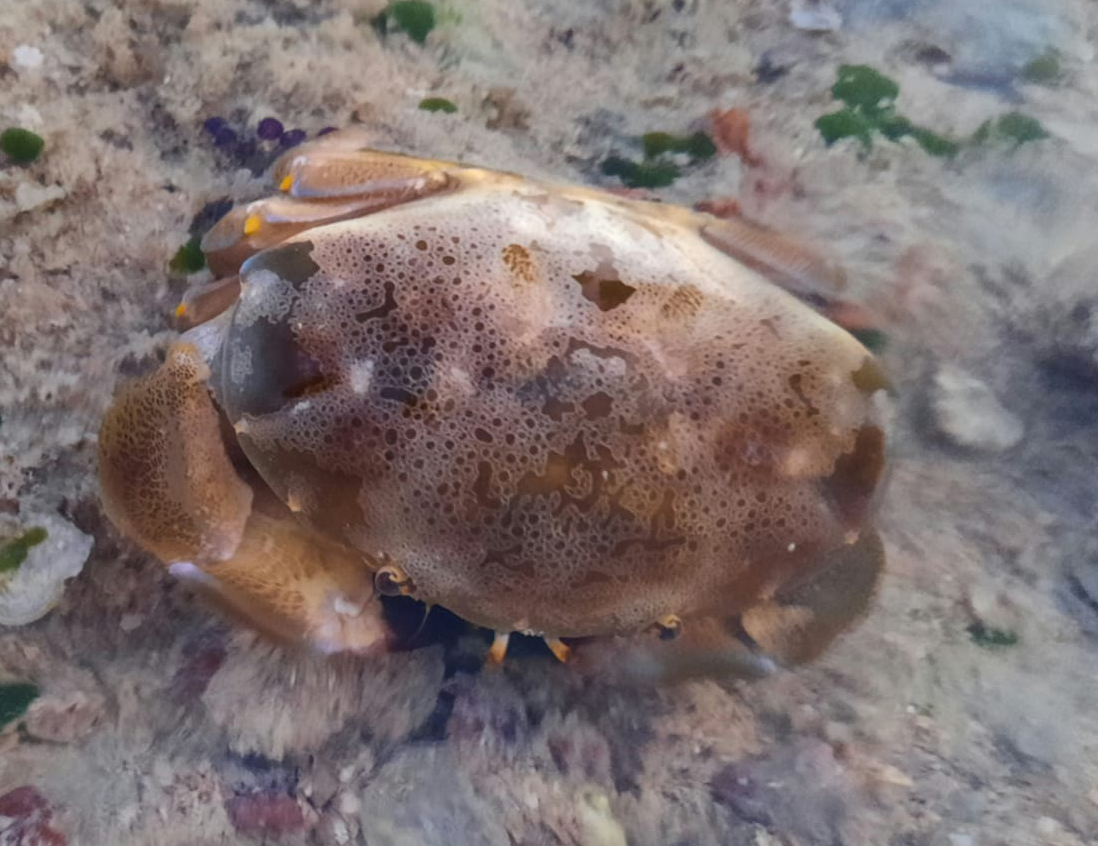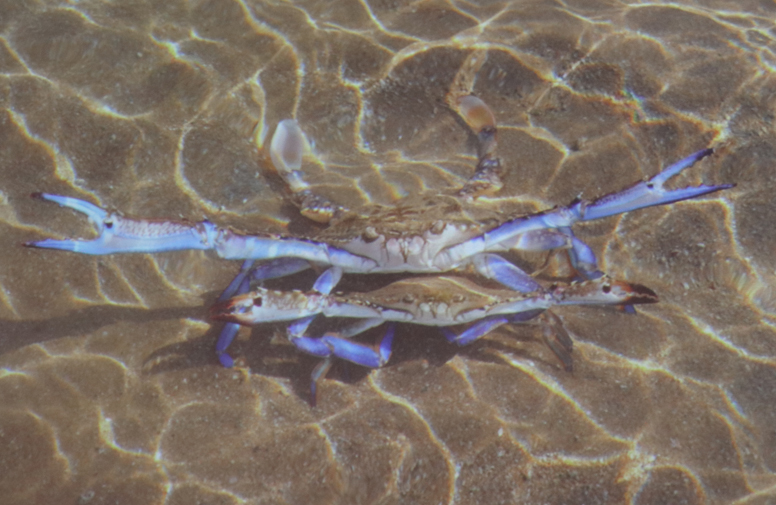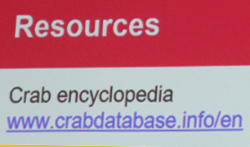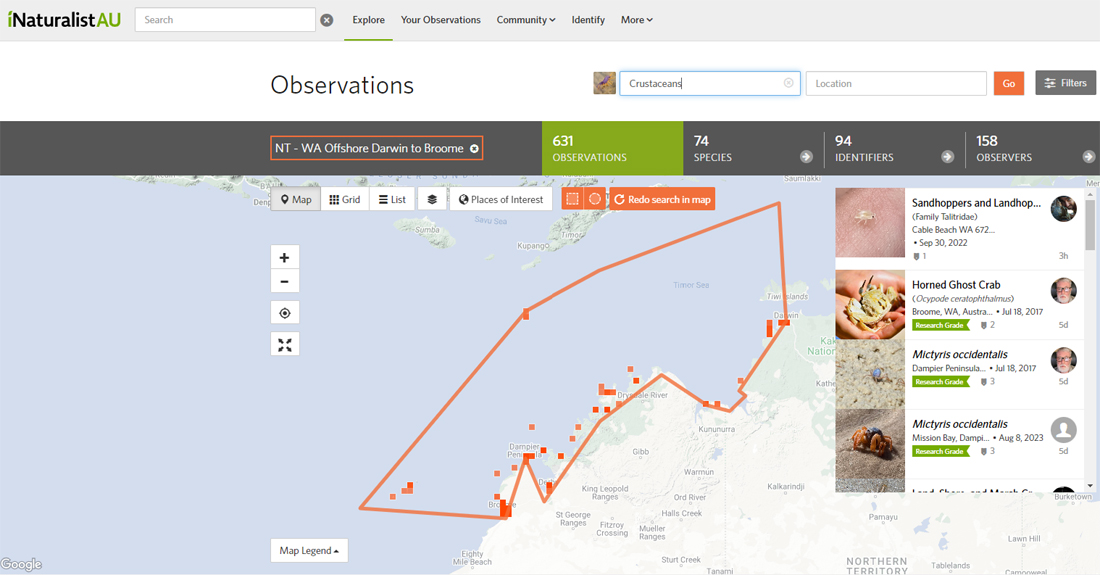 CRABS
CRABS

![]()
There are over 6000 Crab species in the world, 1,200 occur in Australia and of those over 110 species of crabs can be found in Broome. ATLAS OF LIVING AUSTRALIA SEARCH - 170 species of Crustacean as of August 2023 for a 10km radius from Didirrgun (Kennedy's Hill). |
SPECIES LIST OF CRABS FOUND AROUND BROOME downloaded from 'Atlas of living Australia' ala.org.au |
iNaturalist search CRUSTACEANS - BROOME
|
 |
Hermit Crab (Photo BK) |
 |
| Giant red hairy hermit crab (photo Sharmaine Donnelly-Chorlton) |
 |
Photo: Lance Smith
(Paguristes alegrias a member of Left-handed Hermit Crabs Family Diogenidae) |
 |
| Mottled Lightfoot Crab
(Sally-light-foot Crab)
'Grapsus albolineatus' washed up on Cable Beach (photo Cheryl Harry) |
 |
(photo Kevin Smith) |
Elbow Crabs
 |
| This is a baby Elbow Crab - Elbow Crabs are a whole bunch of crabs in the Parthenopidae family. Parthenopids are found all over the world but only some of them have the kind of pincers that provide the mightiest of elbows. (photo: Millie Perry) |
 |
Elbow Crab (Barn Hill photo Taryn Ryan) |
 |
Leucosia ocellata (Geoff Byrne Broome)
https://creativecommons.org/licenses/by-nc/4.0/ |
Fiddler Crabs (Link)
Floral egg Crab
 |
Atergatis floridus (Floral egg crab) closely related to Lophozozymus pictor (Mosaic crab) consumption often results in death. That's right, everything in Australia wants to kill you. Photo Sharmaine Donnelly-Chorlton
(Photo: Rebecca Hayes) |
Ghost Crabs (Link)
Mangrove Crabs
 |
Neosarmatium australiense
Photo: Sharmaine Donnelly-Chorlton |
 |
Neosarmatium australiense(photo Lance Smith) |
Mole Crab
 |
 |
Photos: Lance Smith (Cape Leveque) |
They burrow tail-first into the sand, fully submersing within 1.5 seconds. They use their tough exoskeleton around their heads to protect themselves from predators. |
Mosaic reef Crab
 |
Lophozozymus pictor (photo Geoff Byrne - Entrance Point). The Mosaic reef crab is known to be one of the most poisonous crabs in the world . There are several documented deaths caused by eating this crab. Its neurotoxin does not get denatured by heat even when cooked. It acquires the poisonous neurotoxin from its food, including a poisonous sea cucumber. |
Giant Mud Crab
(30 species of Mud Crabs in Australia)
 |
Mud Crab (Scylla serrata) which seems to have camouflaged itself by adapting and changing its colour to the environment it was in at Willie Creek in the turquoise blue water. Blue morphs have been recorded in other crustacean species. (Photo Rocky Mckenzie) MUD CRABS FEED ON MANGROVE LEAVES |
 |
Wangkaja (Scylla serrata- mangrove crab) |
 |
| Wangkaja is cooked on the coals unit its shell turns orange. |
 |
| Today,the people may boil the Wangkaja (Scylla serrata- Mangrove crab) because the have pots and pans to do so. |
 |
Mud Crab Scylla serrata Matthew Connors |
Pebble Crab
 |
Pebble Crab Leucosia anatum (Geoff Byrne) |
Purse Crab
 |
Purse Crab - Myra australis - Family Leucosiidae https://museum.wa.gov.au/dampier-4732/species_view_speciesID-218.php |
 |
Common hairy crab (Pilumnus vespertilio) Family Pilumnidae (Angela Powell) http://www.wildsingapore.com/wildfacts/crustacea/crab/pilumnidae/pilumnus.htm |
Soldier Crabs
 |
Soldier Crab Mictyris occidentalis (photo BK 24/5/19) Reverse corkscrew to disapper under the sand and mud https://www.facebook.com/sharmaine.donnellychorlton/videos/265426945202259 |
 |
(Soldier crabs on the move Mictyris occidentalis - Photo bk 24/5/19) |
Spider Crabs (also knowns as Decorator Crabs)
 |
|
Spider crab (Paranaxia serpulifera - an Australian endemic http://museum.wa.gov.au/explore/blogs/andrew-hosie/new-species-spider-crab-northern-australia Majoids are also known as decorator crabs because they camouflage themselves by attaching other organisms, such as seaweeds and sponges, to the spines and hairs on their legs and carapace. One of the largest species of spider crabs found in Australia is from the genus Paranaxia . |
 |
Spider Crab (Sharmaine Donnelly-Chorlton) |
 |
Spider Crab
Mojoidea family (dead).
(photo Lance Smith) 15 cm across |
 |
 |
Decorator Crab (photo: Darren Mason) |
Sponge Crab
 |
| The sponge crab family (Dromiidae) is considered one of the most primitive groups of the true crabs, with remnants of a tail fan (seen in lobsters and shrimp) and more primitive reproductive biology in females. The crabs that wear sea sponges like a hat. Forget shells these crabs use a more stylish do for their protection, trimming and fashioning live sea sponges. It is a relationship providing much aid to the crab, but although the sponge remains living it is unclear whether they reap many benefits from their new, mobile host. (Photo Paula Blackman) |
Swimming Crabs
 |
Asian Blue Swimming Crab Portunus pelagicus (photo Meagan Hinde) |
 |
 |
Portunus armatus (Photo: Doris Teufel) |
 |
Big male Blue Swimmer with a small female up front (Photo: Mitchell Franker) |
 |
Ridged Swimming Crab (Sharmaine Donnelly-Chorlton) |
 |
Thalamita crenata (powder blue Claw or crenate crabs (photo bk at the Jetty) |
 |
Metopograpsus latifrons |
 |
Prince (up close and personal at the TAFE Aquaculture Centre) |
 |
Liomera venosa
|
 |
Genus Grapsus |
 |
Naoya Ohtsuchi "Hard to identify due to dense white sediments... but Schizophrys aspera sensu lato" (photo Sharmaine Donnelly-Chorlton at Coconut Wells) |
 |
| Golden sand crab (Lance Smith) |
 |
Matuta is a genus of crabs in the family Matutidae, containing the following species: Matuta circulifera Miers, 1880 Matuta planipes Fabricius, 1798 Matuta purnama Lai & Galil, 2007 Matuta victor Matuta victrix (Photo:
Melanie Haines) |
 |
Actaea flosculata (15mm in length) |
 |
| The Blood Spotted Crab's ocean habitat is sandy or muddy areas about 10-30 m deep and the male size is 140mm while the female is slightly larger - 150mm (shell width). Also known as the Prawn broker crab. (Photo Damian Kelly) |
Spotted Box Crab (Calappa philargius) |
Photos:
Mitchell Franker |
 |
Inland Freshwater CrabAustrothelphusa transversaCommon throughout the semi-desert central and northern parts of Australia extending south into the upper reaches of the Darling River System. It is wonderfully adapted to the arid conditions. Individuals make burrows up to a one metre deep into heavy, dense, clay soils in the banks of freshwater rivers and creeks, drainage channels, pools, swamps and farm dams. During the dry season, or in extended drought conditions of up to six years or more, they plug their burrows with earth and go into a dormant state, living off stores of fat in their tissues. The humidity in the burrows stays high helping the crab to avoid drying out, but it is capable of losing almost a half of its total body water and still survive. Around late October to early November each female lays between 100 and 350 large eggs. Freshwater Crabs are unusual amongst crabs in giving birth directly to miniature versions of the adult. These baby crabs can be kept in an arrested state of development under the abdomen of the mother, in a thin film of water, for up to six months, waiting for rain to come. Only when they are released into a pool do they grow quickly to adulthood. |
 |
Thalamita admete (swimming crab) Photo: Sharmaine Donnelly-Chorlton |






